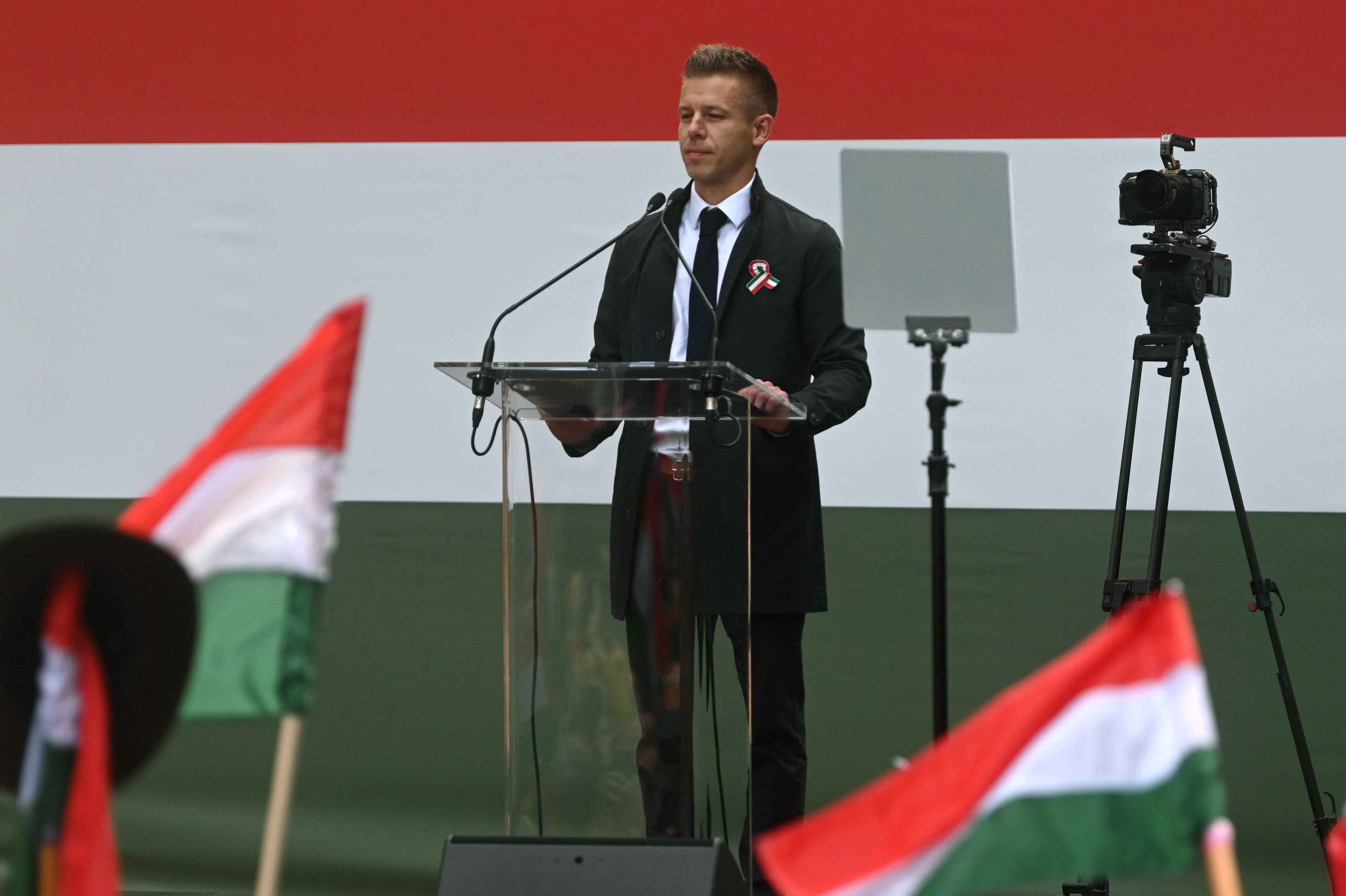Voters to choose between Conservative-Christian and Christian-Conservative leaders

Photo by Sergey Tinyakov / Shutterstock.com
Hungarians cast their ballots on Sunday, April 3, to choose, at least on paper, between two prime ministerial candidates of very similar political leanings.
The Hungarian general election, the eighth since the fall of Communism in 1990, appears odd at first sight: the electorate will ultimately choose between incumbent prime minister Viktor Orbán, a wily veteran of 30-plus years in national politics and who defines his rule as conservative and Christian, and a relative newcomer, Péter Márki-Zay, a marketing expert-cum-economist who leads a broad, six-party coalition but who similarly claims the Christian-conservative mantle.
That is not, of course, how the two view each other: Orbán denounces his opponent as a “leftist” and “clone” of former Socialist Prime Minister Ferenc Gyurcsány (a hate-figure for Fidesz). Márki-Zay, who says he voted for Fidesz up to 2010, labels Orbán a “liar and thief” who has squandered and stolen billions in EU subsidies.

Péter Márki-Zay speaks at a demonstration calling for peace held in front of the Russian embassy in Budapest on February 24, 2022.
Péter Márki-Zay: The new Christian-Conservative on the Hungarian political block
Márki-Zay (or PMZ, to mimic the Hungarian shorthand) appeared on the political scene only in 2018, when, running as an independent, but with the backing of the opposition parties, he defeated the strongly fancied Fidesz candidate in a mayoral by-election in his hometown of Hódmezővásárhely. A polyglot (he speaks English, French, German and some Spanish, as well as his native Hungarian), he repeated that feat a year later.
Aged 49, PMZ entered the national political scene last October when, again as an outsider, he topped the list in the run-off for the common opposition prime ministerial candidate. Thus, without a political party himself, he heads the “United for Hungary” alliance comprising six disparate parties ranging from Jobbik (once far-right, now reformed as democratic national-conservative) to the Socialists, with greens (LMP and Dialogue), center-left Democratic Coalition and Momentum liberals in between.
This begs the obvious question: can they all hang in together? Surprisingly, the mood from inside is positive on this score.
The trials and tribulations of the past four years have “created an opposition community,” says Kata Tüttő, deputy mayor of Budapest and member of the Socialist Party national board.
“This [alliance agreement] is not just a technical agreement, that we ask voters and supporters to support each other. We’ve been fighting, demonstrating, and working together. And not just the politicians, but our supporters, voters and activists. [...] So it’s an opposition community now, not just [a] technical cooperation for power,” she told a recent meeting with foreign journalists.
Asked if Jobbik activists would genuinely support other parties at grass-roots levels, Márton Gyöngyösi, Jobbik’s sole Member of the European Parliament, concurred. “It’s working out very well. Our candidates are running with DK’s [Democratic Coalition] support, and DK candidates are running with Jobbik’s support. Our people understand [the needs],” he told the BBJ.
PMZ himself sticks to a tight criticism of the current government, accusing Prime Minister Viktor Orbán of creating “crony capitalism” that primarily favors family and friends. He promises “a level playing field” for business, regardless of political affiliation. He has pledged to keep all the tax and other benefits introduced by Fidesz in the past 12 years while putting those on a minimum wage into a tax-free bracket and reducing the VAT rate on basic foodstuffs.
Under a PMZ government, Hungary would be pro-EU, seeking to adopt the euro within five years while keeping Russia and China at a more arms-length distance. Public education and healthcare would receive top priority, making all this affordable by cutting out corruption in the funding processes.
Yet, despite its promises, the opposition alliance is struggling to regain the momentum created by the opposition primaries in the fall. The latest poll by Publicus, a left-leaning pollster, indicated that while 42% of Hungarians want a change of government (with 39% seeking to re-elect Fidesz), only 31% would vote for the In Unity for Hungary alliance, against 33% supporting Fidesz.
Given that Publicus found 32% of the electorate is undecided, there is an ongoing teacher’s strike, and inflation is at more than 8%, the opposition alliance remains in the competition. But against an experienced incumbent with massive funding and media power, 12 days before the poll that counts, it looks like an uphill struggle.

Viktor Orbán speaking to press in Downing Street after meeting with U.K. PM Boris Johnson on May 28, 2021.
Viktor Orbán: Liberal-youth activist turned Conservative-Christian with a deeply committed following
Today, the incumbent Hungarian prime minister is indisputably the best-known politician to emerge from the former Soviet-dominated “Warsaw Pact” countries of Central and Eastern Europe. The winner of four general elections, beginning in 1998, followed by consecutive victories in 2010, 2014 and 2018, this one-time anti-communist student dissident has led Hungary for precisely half of the 32-year period that has followed the demise of the Communist regime in 1990.
In that time, Orbán has steered his once liberal Fidesz party onto a right-wing course which, he declares, represents classical European Christian, conservative and democratic values while simultaneously enforcing his interpretation of those values on the country. This has been particularly the case since 2010, during which time his government has mostly held a “constitutional majority” of 67% or more in parliament. This majority, invariably acting in line with government policy, has enabled the prime minister to amend and enact laws requiring a two-thirds majority in the house at will.
The prime minister highlights the country’s recovery in the last 12 years from the 2008-09 global crisis, a recovery based upon hundreds of foreign and domestic investment projects which has led to sustained economic growth since 2013 (barring the hiccup of the COVID pandemic in 2020). Simultaneously, the country now boasts record low unemployment levels of less than 4% and record nominal wage growth averaging some 10% annually for the past four years. Coupled with some of the lowest tax rates globally (at least concerning personal income and corporation taxes) and a slew of generous subsidies for home building and young families, this, in turn, has led to a housing boom and a fast-growing middle class.
Opposition critics, however, charge that the full price of these policies has yet to be paid, including, for example, the energy price caps, which have resulted in delayed but essential, maintenance. They are also quick to point out that the easy money of Orbán’s reign has been primarily to the benefit of family members and business friends and resulted in a one-third devaluation of the forint and inflation climbing to 8%.
Moreover, Orbán’s fascination with prestigious and frequently economically dubious projects, ranging from oversized football stadia and narrow-gauge railways to the massive museum building program in Budapest’s City Park, has meant less glamorous, strategic sectors such as health and education being starved of proper funding.
Orbán delights in making quick and bold decisions and, despite the problems that at times result, has a knack of explaining away or diverting attention from the consequences, at least to the complete satisfaction of his voters.
Take, for example, Hungary’s track record regarding the coronavirus. The prime minister trumpets success in handling both the economic and medical aspects of the pandemic, with the government continually referring to the fast vaccination programs of 2021. The line seems to work: Despite the high death rate (at the time of going to press, the official COVID toll stands at well over 45,000, equating to 4,700 deaths per one million population, meaning Hungary is the fourth-worst performer globally) and needless mass expulsion of patients from hospitals over Easter in the first wave, public opinion polls indicate even opposition voters assess the government’s handling of the pandemic has been good.
Indeed, Orbán’s ability to resonate with the heartstrings of his supporters is the stuff of legend. This frequently involves references to highly questionable interpretations of historical events, typically referring to some perceived foreign mistreatment or betrayal of the Magyar cause. It has been a long-running preoccupation for the man from the village of Felcsút (46 km west of Budapest by road).
“The emotion-filled explanation of the bad fate of Hungarian history. It was the continuous topic of conversation among [Orbán and fellow students], even in the ’80s,” says László Kéri, who supervised the dormitory where they lived as undergraduates.
“I went up the wall when I heard this. It’s ridiculous because they don’t know anything about [say] Irish, Finnish, Greek or Polish history,” Kéri adds.
Maddening or not, it surely works for Orbán’s core voters, especially those in rural areas with limited access to information and where the critical assessment of complex issues is rarely the stuff of conversation in street or pub.
It also helps to bolster the image of Orbán as a wise father figure defending the Hungarian nation, above and beyond the daily, unseemly squabbles of party politics. It is an image his communication team has been seeking to create for some years. Thus far, it has been a core element of Orbán’s political success. And with a war next door to the east, it is an image seemingly ideal for further success on April 3.
Hungary’s Election system: Evolution and basic elements
The Hungarian election system can, at first sight, be bewildering. This overview outlines its historical roots and how it works in practice today.
In 2010, after Fidesz’ sweeping election victory that spring, the government, without consulting opposition parties, created a new election law. The new system has only one round of voting (a change from 1990-2010, when there had been two), with a total of 199 parliamentary seats (down from 386 previously).
MPs are elected in one of two ways: 106 represent individual constituencies across the country, with the remaining 93 appointed via the so-called “party lists.”
The government argued the new system was fairer, cheaper and more understandable. Critics, though in favor of the smaller parliament, accused the government of gerrymandering the new constituencies by, for example, diluting opposition-supporting populations (generally in urban areas) into surrounding, government-leaning rural populations.
Regardless, many ordinary Hungarians struggle to fully understand the new system, along with its electoral implications.
“The system has many majoritarian elements, meaning it favors the largest party, even if it only wins a minority [i.e., less than 50%] of the constituency votes,” says Róbert László of Political Capital.
Citizens with a registered address in Hungary receive two votes. One is for their choice of candidate for their constituency. It is a first-past-the-post race; the candidate with the most votes wins the seat.
The second vote is for the “party list.” Citizens vote for the party of their choice (usually, but not always, the same party represented by the candidate they voted for in the constituency vote). This list vote is added to a national pot. Up to 93 MPs are then chosen according to the proportion of votes in the pool.
Parties must achieve at least 5% of the total list vote to qualify for list seats. Fail to hit this threshold, and those votes are lost.
Also added to the pot are the “surplus” votes of the losing candidates in the constituency fights. This practice is quite common in mainland European elections; the whole purpose of the list is to compensate the losers in the first-past-the-post individual constituency vote, giving them at least some representation in parliament. (This is in contrast to, for example, the United Kingdom system, whereby the losers’ votes fail to gain any representation whatsoever, even if the winner defeats the nearest competitor by just one vote.)
However, in an element unique to Hungary, the new election system includes what might be called the winner’s “surplus booster” component, whereby the “excess” votes of the winning candidate are also added to the pot.
As an example of how this works, let us consider the result of the constituency vote for the fictitious seat of Délváros.

In this example, Ágnes becomes the constituency MP. It also illustrates how multiple candidates divide the opposition vote, enabling Ágnes to win the seat despite garnering only 43.5% of the total vote.
Csilla, as an independent, does not have a party list, so her 10,000 votes are lost, yielding no result whatsoever.
The votes for Balázs and Dénes go to the compensation pot for their respective lists, Greens (one party within the opposition alliance) and Reds. (However, this assumes the Reds attract enough votes to cross the 5% threshold, which would appear unlikely if the trend in this example continued elsewhere.)
Now for the winner’s “surplus booster.” In this example, Ágnes only needed 15,001 votes to beat Balázs and win the seat, but she polled 20,001, giving 5,000 “surplus votes,” which were not necessary to defeat her strongest opponent. According to the 2010 election rules, these 5,000 votes are also added to the list pot for the Blues. (This, despite critics arguing it goes against the very purpose of the compensatory list.)
Hungarian citizens living abroad with a registered address in Hungary get two votes (like their compatriots at home), but they can only vote in person at a Hungarian embassy, consulate or designated polling station. They may not use postal ballots.
Citizens not registered at an address in Hungary may vote by post but only receive one vote, valid for the party list.
This illustrates the essence of the electoral system but is a somewhat simplified explanation that does not list all elements.
The ‘Child-protection’ referendum
Somewhat complicating this year’s general election, voters on April 3 are simultaneously invited to participate in the government-sponsored “child-protection” referendum. However, the two are, legally, totally separate processes.
In the summer of 2021, the government drafted a bill against pedophilia, controversially slipping in some late amendments severely restricting the dissemination of literature, information or even discussion of homosexuality and gender transition in schools.
LGBTQI (lesbian, gay, bisexual, transgender, queer and intersex) groups were outraged, saying the amendments are intentionally vague (making them open to broad interpretation), conflating two entirely different issues, and falsely painting homosexuals as pedophiles. The European Union has also been critical.
The government called the referendum to bolster its position on the law, and citizens will have the right to vote on four questions regarding the sexual education of minors. Opponents of the vote insist the questions are totally slanted and violate fundamental human rights.
The referendum must attract at least 50% of the total electorate to be valid. Opposition groups are asking voters to invalidate the ballot by writing crosses in both the “yes” and “no” boxes.
This article was first published in the Budapest Business Journal print issue of March 25, 2022.
SUPPORT THE BUDAPEST BUSINESS JOURNAL
Producing journalism that is worthy of the name is a costly business. For 27 years, the publishers, editors and reporters of the Budapest Business Journal have striven to bring you business news that works, information that you can trust, that is factual, accurate and presented without fear or favor.
Newspaper organizations across the globe have struggled to find a business model that allows them to continue to excel, without compromising their ability to perform. Most recently, some have experimented with the idea of involving their most important stakeholders, their readers.
We would like to offer that same opportunity to our readers. We would like to invite you to help us deliver the quality business journalism you require. Hit our Support the BBJ button and you can choose the how much and how often you send us your contributions.








